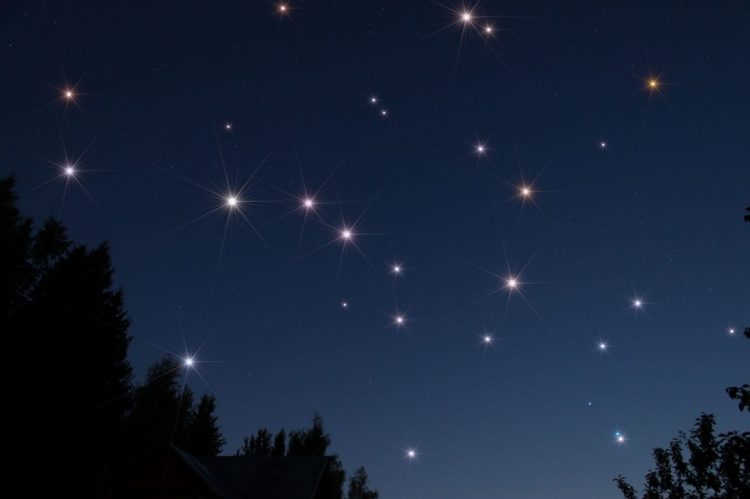The Big Dipper is a constellation located in the northern hemisphere of the celestial sphere. The seven stars that comprise the Big Dipper create a shape resembling a bucket with a handle. The two most radiant stars, Aliot and Dubhe, have an apparent sidereal magnitude of 1.8. By connecting the two outermost stars of this configuration (α and β), one can find Polaris. The optimal visibility conditions occur in March-April. It remains visible throughout Russia all year long (except for the autumn months in southern Russia, when the Big Dipper dips low on the horizon).
There are approximately 125 stars in this constellation, but only seven are referred to as the largest and most radiant: Dubhe, Merak, Fekda, Megrets, Aliot, Mitsar, and Alkaid. Together, they form a dipper shape that is visible to the naked eye.
Legend of the Big Dipper’s Appearance
Far away in Greenland, there exists a legend surrounding the appearance of the Big Dipper constellation. This cluster holds great significance in mythology and history, captivating the minds of many. Among the Eskimos, there is one particular story that has gained immense popularity and is shared by all. Some even argue that this legend is not mere fiction, but rather the purest truth.
In a snow-covered dwelling, nestled on the very edge of Greenland, resided the renowned hunter Eriulok. Preferring solitude, he lived alone in his humble abode, driven by his arrogance and conviction of being the finest in his craft. He had no desire to socialize with his fellow tribesmen. Year after year, he embarked on daring sea expeditions, always returning with abundant spoils. The walls of his dwelling were adorned with the finest skins of walruses, seals, and sea lions, while his home was well-stocked with an abundance of food and seal oil.
Eriulok, although wealthy and well-fed, was plagued by a sense of isolation. The weight of his loneliness became increasingly burdensome for the skilled hunter. He attempted to form bonds with his fellow Eskimo tribesmen, but they shunned his arrogant nature, likely due to past offenses he had committed against them. Filled with despair, Eriulok ventured to the Arctic Ocean and called upon the goddess Arnarkuachssak, the ruler of the depths. He poured out his heart to her, sharing the depth of his troubles. In response, the goddess offered her assistance, but with a condition – Eriulok had to retrieve a ladle filled with magical berries that possessed the power to restore the goddess’s youth. Determined to remedy his loneliness, the hunter agreed and embarked on a journey to a remote island where he discovered a cave guarded by a formidable bear. After enduring great hardship, he managed to lull the beast into a deep sleep and seize the ladle containing the precious berries. True to her word, the goddess bestowed upon Eriulok a loving wife, and in return, he was granted the magical berries.
Following his numerous exploits, Eriulok tied the knot and embraced fatherhood, becoming the proud patriarch of a bustling brood that left the neighbors green with envy. As for the divine deity, she devoured every last berry, regressing several hundred centuries in age, and gleefully flung the now-empty ladle into the heavens, where it snagged on an unknown object and remained suspended.
Stars and constellations.

The constellation known as the Big Dipper is the third largest in terms of area, following Hydra and Virgo. Its seven prominent stars create the famous Big Dipper formation, which has been recognized since ancient times by various cultures with different names such as The Bucket, The Plow, The Elk, The Wagon, The Seven Sages, and more. Each star in the Big Dipper has its own unique Arabic name:
- Dubhe (α of the Big Dipper) translates to “bear”;
- Merak (β) translates to “loins”;
- Fekda (γ) translates to “thigh”;
- Megretz (δ) signifies “the beginning of the tail”;
- Aliot (ε) – the meaning is unclear, but it is likely to refer to “curd”;
- Mitsar (ζ) – translates to “girdle” or “loincloth”.
- In the Greek letter star designation system, the order of letters corresponds directly to the order of stars.
- Another interpretation of the asterism is found in its alternate name, “The Catafalque and the Mourners”. In this interpretation, the asterism is seen as a funeral procession, with mourners leading the way and a leader guiding them, followed by a funeral stretcher. This explains why the star η of the Big Dipper is called the “leader of the mourners”.
The celestial bodies within the Big Dipper
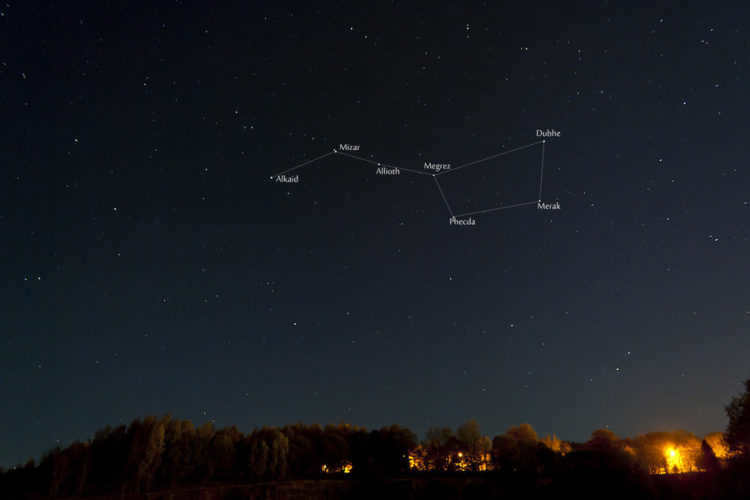
There is a particular group of stars in space, known as the moving cluster of the Big Dipper, which consists of the 5 inner stars of the Ladle (excluding the outermost α and η). This cluster moves across the sky at a relatively fast pace. Interestingly, Dubhe and Benetnash move in the opposite direction, causing the shape of the Ladle to change significantly within a span of approximately 100,000 years.
The constellations Merak and Dubhe.
create the wall of the Bucket and are commonly referred to as the Pointers because if you draw a straight line through them, it will lead you to Polaris, the star in the Little Bear constellation. There are six stars in the Bucket with a brightness of 2nd magnitude, while Megrez stands out with a brightness of 3rd magnitude.
Alcor
Located next to Mizar, which was the second double star discovered through a telescope (Giovanni Riccioli in 1650; although it is believed that Galileo may have observed it as a double as early as 1617). With a keen eye, you can spot the 4th magnitude star Alcor (80 of the Big Dipper), which translates to “forgotten” or “insignificant” in Arabic. It is said that the ability to discern Alcor has been a test of visual acuity since ancient times. The pairing of Mizar and Alcor is often referred to as the asterism “Horse and rider.”
An asterism known as The Three Leaps of the Gazelle, which has its roots in Arabic culture, is composed of three sets of closely positioned stars. These sets are aligned in a straight line and are separated by equal distances. This asterism is said to resemble the hoofprints of a gazelle as it leaps. The stars that make up this asterism include:
- Alula North and Alula South (ν and ξ, representing the first leap)
- Taniyah North and Taniyah South (λ and μ, representing the second leap)
- Talitha North and Talitha South (ι and κ, representing the third leap)
Arcturus
can be rephrased as
The Brightest Star in the Northern Hemisphere
.
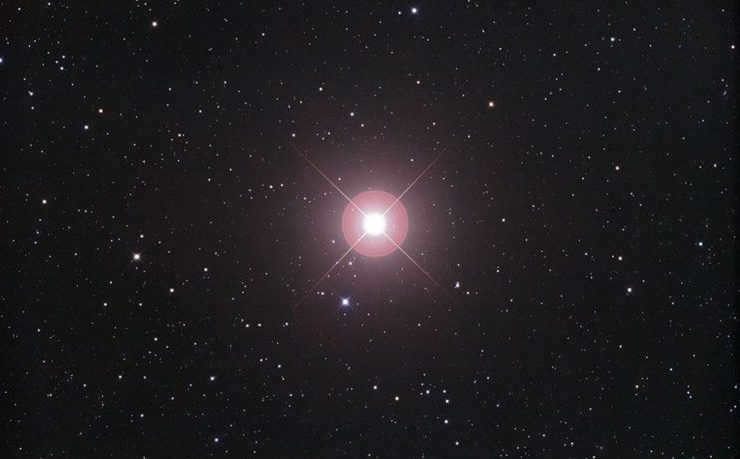
In the night sky, you can find an extended arc formed by the stars Aliot, Mizar, and Benetnash. This arc is especially notable because it points directly to Arcturus, which is the brightest star located north of the celestial equator. In Russia, Arcturus is also the brightest star that can be seen during the spring season in the middle latitudes. If you continue to extend this arc further south, it will eventually lead you to Spica, which is the brightest star in the constellation Virgo.
Laland 21185.
An inaccessible red dwarf located near Alula Severnaya, Laland 21185 is one of the star systems closest to Earth. While it cannot be seen with the naked eye, it is in close proximity to Alpha Centauri, Barnard’s Star, and Wolf 359. Another star that can be observed with binoculars is Groombridge 1830, which has a similar motion to Barnard’s star and Kapteyn’s star. Over the course of a hundred years, it moves about a third of the lunar disk.
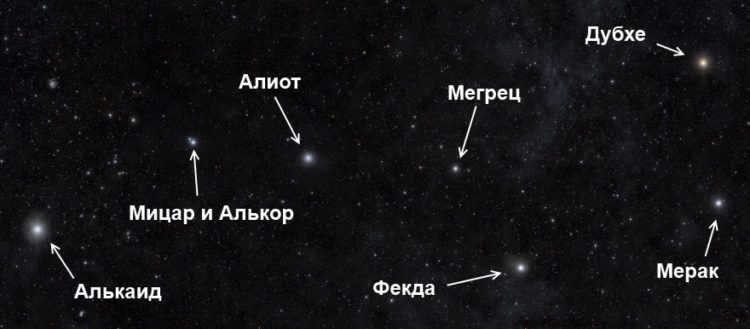
Legends and stories abound about the cluster of stars known as the Big Dipper and the Little Dipper. One such tale revolves around Dubhe, the brightest star in the Big Dipper constellation. According to the legend, Callisto, the beautiful daughter of King Lycaon, served as a huntress for the goddess Artemis. The mighty Zeus became enamored with Callisto and they had a son named Arkas. However, Zeus’ jealous wife Hera transformed Callisto into a bear as punishment. When Arkas grew up and became a hunter, he unknowingly stumbled upon his mother’s bear form and prepared to shoot it with an arrow. Zeus, witnessing this, intervened and transformed Arkas into a smaller bear. To ensure that mother and son would always be together, Zeus placed them in the night sky as constellations.
The Big Dipper is the third largest constellation in terms of area, but it has a surprisingly low number of variable stars. As of 2011, it does not rank among the top ten constellations in terms of this indicator.
- A Hubble Ultra Deep Field image has been captured in a region that is one-twelfth the size of the lunar disk near the star Megrez. As of 2011, it is one of the most detailed images of the night sky, allowing us to distinguish numerous galaxies that are billions of light years away from Earth.
- The character Kenshiro from the popular anime and manga series Hokuto No Ken wears scars in the shape of the Big Dipper constellation on his chest. Currently, only the standalone three-part novella Fist of the North Star: New Era is officially translated into Russian.
- The cryogenics company, which is the first of its kind in the world, is named after a star in the Big Dipper constellation.
- In his renowned work, Soviet archaeologist and historian, B.A. Rybakov, who is an academician of the Russian Academy of Sciences, mentioned that the Big Dipper constellation is referred to as “Elk” or “Sokhaty” in the Russian North. In the Poles, the Polar Star is called the “Elk Star” (Gwiazda Łosiowa). The Evenks have named the Big Dipper constellation (Ursus Major) “Moose Haglen”.
- In the animated series “Gravity Falls”, the protagonist Dipper Pines has a birthmark on his forehead in the shape of the Big Dipper constellation. This birthmark is the reason behind his nickname “Dipper”, which is a reference to the constellation itself.
Let’s get started. A group of stars known as The Big Dipper is undoubtedly the most easily identifiable constellation in the entire northern hemisphere. It stands out with its seven brilliant stars that form a shape resembling a bucket.
Mythology and past
This constellation derives its name from the nymph Callisto and is surrounded by various fascinating stories and historical accounts. One of the legends goes something like this.
The Big Dipper is an ancient constellation in the night sky. It shares the same name among the Slavs, Indians, and Greeks. It is featured in Claudius Ptolemy’s “Almagest” star catalog.
The Big Dipper consists of seven stars that form the shape of a bucket with a handle. However, this is just a small portion of the entire constellation.
Distinctive Qualities
| Name in Latin | Ursa Major |
| Abbreviation | UMa |
| Region | 1280 square degrees (Ranked 3rd) |
| Vertical position | From 7 h 58 m to 14 h 25 m |
| Declination | +29° to +73° 30′ |
| Brightest Stars (Stars of the Great Bear) |
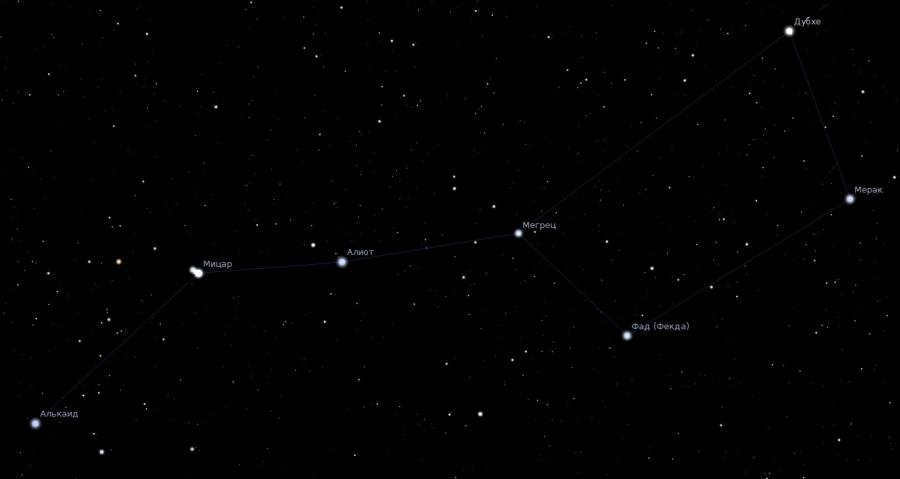
The Big Dipper consists of the following seven stars:
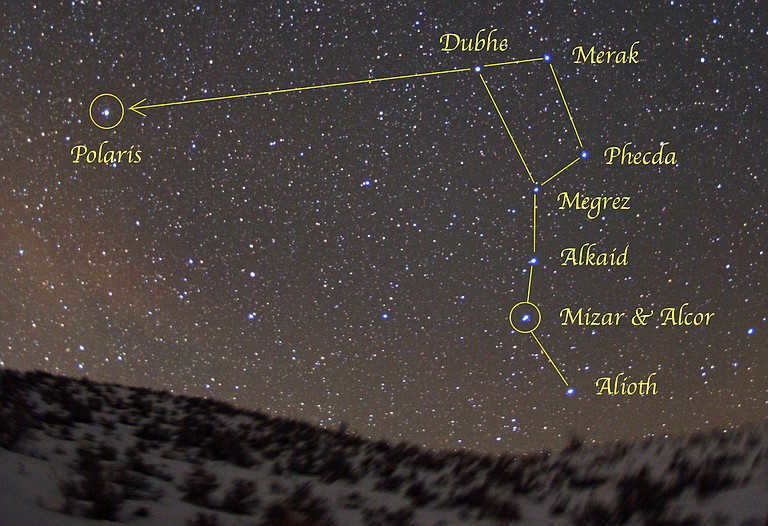
It is worth mentioning that the constellation of the Big Dipper also goes by another name, “The hearse and the Mourners”. According to this interpretation, the three stars represent the mourners, led by a leader (“Al-kaid banat nash”), with the funeral stretcher following behind.
On average, the stars that make up the Great Dipper are situated approximately 120 light-years away from Earth. These stars are not the brightest in our night sky, with an average stellar magnitude close to 2m. Nonetheless, most people will have no trouble spotting them in the heavens.
There exists a moving cluster within the Big Dipper constellation, comprising of 14 stars. 13 of these stars are part of the Big Dipper, while 5 are part of the Big Bucket (Merak, Fekda, Megrets, Aliot, and Mitsar). The stars within this cluster move in unison in one direction, except for the other two stars in the Bucket (Dubhe and Benetnasha) which move in the opposite direction, causing the shape of the Big Bucket to undergo noticeable changes over a span of 100,000 years.
It is worth mentioning that a recent study conducted in 2009 revealed that Mizar and Alcor are actually a six-star system, with the double stars Mizar A and B orbiting around the double star Alcor. It is not uncommon for stars to be born and exist in pairs or clusters.
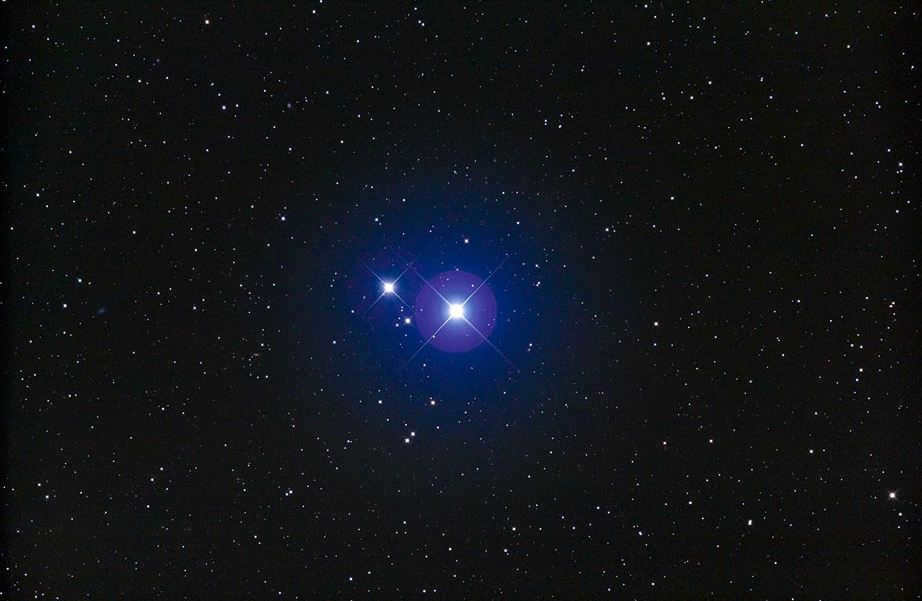
Additional entities in the Great Bear
Aside from the Great Bear, there is also a cluster of stars known as the Three Leaps of the Gazelle, which appears as three sets of stars in the constellation of the Big Dipper. The star pairs are as follows:
- Alula North South (ν and ξ),
- Taniyah North and South (λ and μ),
- Talitha North and South (ι and κ).
Close to Alupa Severnaya is a red dwarf named Laland 21185, which cannot be easily seen with the naked eye. However, it is the sixth nearest star system to the Sun, closer than the stars Sirius A and B.
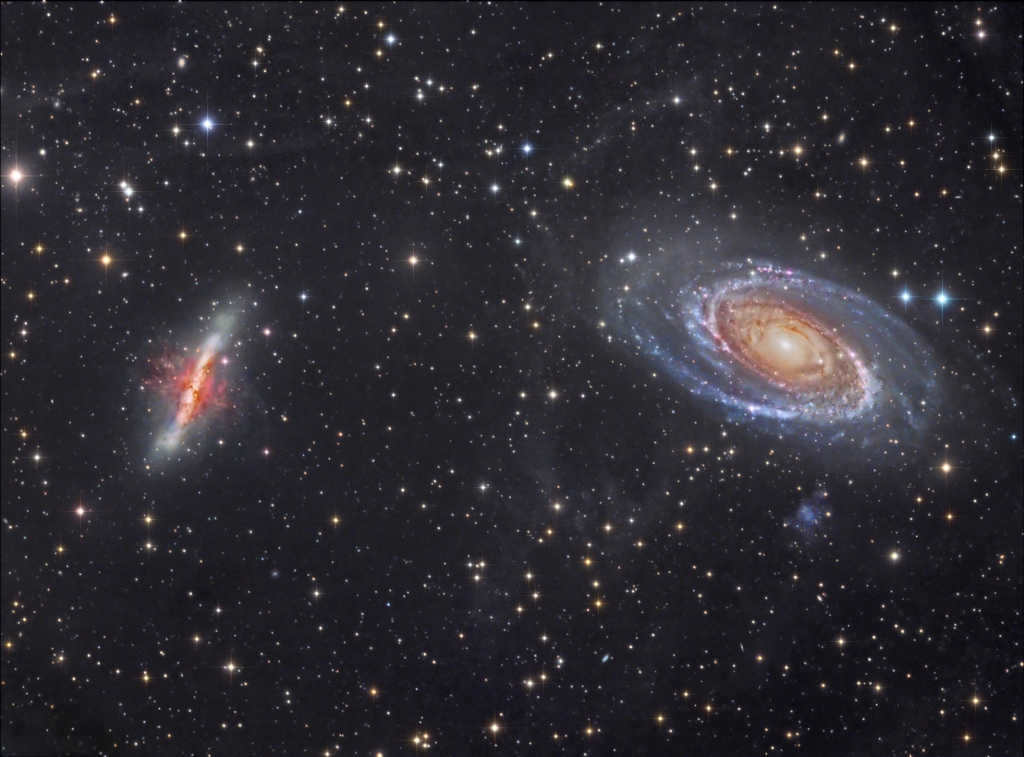
Between the first and second “gazelle jump”, there is a small yellow dwarf that can be observed with the aid of optics. This dwarf resembles our Sun and is located at position 47. From 2000 to 2010, scientists made the discovery of three gas giant exoplanets that orbit around this dwarf. This star system is also one of the most similar to our Solar System and is ranked 72nd on the list of potential candidates for Earth-like planets. This ranking is part of the NASA Terrestrial Planet Finder mission. Therefore, for those interested in astronomy, this constellation holds significant interest.
In 2013 and 2016, two of the most distant galaxies, z8 GND 5296 and GN-z11, were found within this constellation. The light from these galaxies, as recorded by scientists, has traveled for 13.02 billion years (z8 GND 5296) and 13.4 billion years (GN-z11).
It is worth mentioning that the Big Bucket is featured on the flag of White Sea Karelia and on the flag of Alaska, along with the North Star.
Here are the flags of Alaska (left) and White Sea Karelia (right):
In the 2nd grade course “The World Around Us,” schoolchildren are introduced to the Big Dipper constellation.
Learning how to locate the “dipper” in the night sky is important for children, as it serves as a guide for finding numerous other celestial objects.
Description of the constellation of Ursa Major
The constellation Ursa Major, also known as the Big Dipper, can be found in the northern hemisphere and is ranked as the third largest in terms of magnitude. This celestial object gets its name from its resemblance to a dipper with a long handle, formed by its seven main stars.
In Eastern Europe and all of Russia, this constellation can be observed throughout the year (with the exception of the fall season in southern Russia, when it is too low above the horizon). The best visibility is during the early spring months.
The Big Dipper has been recognized by humans since ancient times and holds significant cultural importance in many societies. It is mentioned in the Bible, Homer’s “Odyssey”, and described in the works of Ptolemy.
Ancient civilizations associated the star formation with various objects such as a camel, a plow, a boat, a sickle, and a basket. In Germany, the constellation is referred to as the Great Basket, while in China it is known as the Imperial Chariot. In the Netherlands, it is called the Saucepan, and in Arab countries, it is referred to as the Grave of Mourners.
How many stars make up the Big Dipper constellation? There are a total of seven stars, and each of them has fascinating names in different cultures. The people of Mongolia refer to them as the Seven Gods, while Hindus call them the Seven Sages.
According to the beliefs of Native American tribes, the three stars that form the “handle of the dipper” represent three hunters in pursuit of a bear. Alpha and Beta of the constellation are also known as the “pointers” because they can easily guide one to Polaris, the North Star.
The changing position of the Big Dipper throughout the seasons
Throughout the year, the Big Dipper, also known as the “Bear,” occupies different positions in the sky relative to the horizon. To navigate effectively, it is advisable to utilize a compass.
During a clear spring night, the cluster of stars can be seen directly above the observer. As the months progress, starting from mid-April, the Dipper gradually shifts westward. Throughout the summer, the constellation continues its northwest trajectory, descending lower in the sky. By the end of August, the stars become visible in the northern region, positioned as close to the horizon as possible.
In the fall sky, one can observe the constellation slowly ascending. Over the winter months, as depicted in the diagram below, it moves towards the northeast, rising once again by spring to its highest point above the horizon.
Depending on the time of day, the position of the stellar figure varies not only in relation to the celestial vault but also to its own axis. The illustration below demonstrates that during the evening in January-February, the “bucket” can be found in the northeast (as seen in the right picture), with its “handle” pointing downward.
Throughout the night, the constellation follows a semicircular path, reaching the northwest by morning (as depicted in the left picture), while the “handle” rises upward.
In July and August, the daily changes are reversed. The same reversal is observed during the spring and fall months.
Each season of the year is characterized by a specific diurnal change in the constellation’s position in the sky.
Stars in the Great Bear
When considering how many stars are in the Great Bear, we typically refer to the 7 most prominent ones. These seven stars make up the well-known shape of the “Big Dipper,” which can be easily seen in the night sky.
However, the constellation is actually more extensive, consisting of additional stars. These fainter stars form the bear’s paws and face.
The seven primary stars that compose the constellation are:
- Dubhe (the brightest star in the constellation, second only to the alpha star. It serves as one of the two markers for the North Pole. Dubhe is a red giant located 125 light-years away from Earth.
- Merak (also known as “lumbar”) is a beta star and serves as the second guide to the North Pole. This celestial object is situated approximately 80 light-years away from Earth, slightly larger than our Sun, and emits a powerful infrared radiation stream.
- Fekda (meaning “hip”) is a gamma-ray dwarf star located just under 85 light-years from our planet.
- Megrez (derived from Arabic, meaning “base”) is a delta star, specifically a blue dwarf, situated more than 80 light-years away from Earth. It earned its name due to its position as the base of the “celestial beast’s” long tail.
- Aliot (also referred to as “tail”) is an epsilon star and holds the distinction of being the brightest point within the constellation. It ranks 31st in terms of luminosity among visible objects in the sky, boasting a stellar magnitude of 1.8. This white star is 108 times more luminous than our Sun and is one of the 57 celestial objects utilized in navigation.
- Mizar (an Arabic term meaning “belt”) is the fourth brightest star in the “bucket” constellation. It is a binary star system and has a companion star called Alcor.
- Alkaid (also known as Benetnash, meaning “weeping”) is the third most luminous star and marks the end of the “bear tail” in the constellation. It is a blue dwarf star located approximately 100 light years away from Earth.
The constellation contains approximately 125 celestial objects.
Among these, three pairs of stars are worth mentioning as they are aligned in close proximity to each other:
- Alula Borealis (nu) and Alula Australis (xy);
- Taniya Borealis (lambda) and Taniya Australis (mu);
- Talitha Borealis (jyota) and Talitha Australis (kappa).
These three pairs are known as the three leaps of the gazelle, and in the diagram below, they are located at the lower part of the group of stars.
The diagram displays the positions of the main seven stars and objects of the Talitha, Tania, and Alula clusters.
The Story of the Great Bear
There exists an ancient Greek legend that explains the reason behind the name of the constellation known as the Great Bear.
Callisto, the daughter of King Lycaon, was one of the most stunning nymphs in the service of Artemis. Zeus was captivated by the beauty of the young girl. He transformed into Artemis and deceived Callisto. When the goddess discovered that her beloved nymph was pregnant, she became furious and banished her. The unfortunate Callisto sought refuge in the mountains, where she eventually gave birth to her son Arkas.
Although the primary deity forbade his offspring from carrying out a dreadful act, he was unable to overcome the curse bestowed upon him by the Hero. Feeling compassion for the hapless Callisto, Zeus transformed her and her child into celestial bodies, placing them in the heavens. As a result, the constellation known as the Big Dipper emerged, accompanied by its counterpart, the Little Dipper.
How to locate the Big Dipper in the sky
In the temperate zone of Russia, the “Ursa Major” is considered a circumpolar constellation, as it is situated near the North Pole. It is relatively easy to spot the “Big Dipper” in the sky during the evening and nighttime. Once you have seen the star cluster, it becomes recognizable and memorable.
Below, you can see a photo depicting the potential appearance of the “Big Dipper” in the night sky.
For those residing at the latitude of Moscow, the optimal time to observe the star cluster is during the nights of April. Between 11 PM and 12 AM, the “Big Dipper” will be directly overhead. Observers will simply need to connect the dots to form the constellation.
If it is not April, and you are unable to see the “Ursa Major” constellation, you can search for it in other parts of the sky:
- In January-February, the constellation is positioned vertically with an angle of 30-70° above the horizon in the northeast direction.
- During March, the figure is almost vertical with an angle of 50-80° in the east.
- From May onwards, the constellation can be seen in the west with an angle of 60-90°, and the “bucket” shape is tilted downward at an angle of 60-80°.
- In June-July, the constellation is visible in the northwest with an elevation of 40-70° above the horizon. The figure slopes downward at an angle of 20-60°.
- During August-September, the constellation can be observed in the northwest (closer to the north) with an angle of 20-50°. The figure appears parallel to the horizon.
- In October, the constellation is located in the north with an angle of 20-30°. The “bucket” shape is inclined upwards at an angle of 10-30°.
- In November-December, the constellation is in the northeast (closer to the north) with an angle of 20-40°. The figure is inclined upwards at an angle of 30-80°.
Once you have become familiar with the Big Dipper, your opportunities for stargazing expand significantly. Polaris is the initial star that can be located by knowing the position of the large “bucket”. Furthermore, Polaris (the alpha star of the Little Dipper) serves as the primary celestial reference point in both hemispheres.
Most likely, every adult can recall the enchanting lullaby song from the classic Soviet cartoon about Umka. It was this cartoon that introduced young viewers to the constellation of the Big Dipper for the first time. Thanks to this beloved cartoon, many individuals developed an interest in astronomy and desired to learn more about this uniquely named collection of brilliant celestial bodies.

